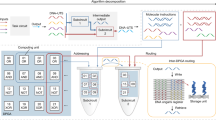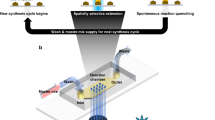Abstract
DNA has recently emerged as a powerful and novel material for creating nano-scale electronic architectures and devices. Based on DNA strand displacement (DSD) reactions, sophisticated multilayered DNA molecular circuits have been rationally designed to perform different functions. In this paper, a code converter circuit, which can be used to compute logic states of a seven-segment digital tube, is designed for decimal numbers displaying. In addition, the logic circuit is further translated into its correspondingly dual-rail circuit and seesaw cascade circuit. The simulation results show that our logic circuits are effective and feasible for decimal numbers displaying.
Access this chapter
Tax calculation will be finalised at checkout
Purchases are for personal use only
Similar content being viewed by others
References
Beaver, D.: Computing with DNA. J. Comput. Biol. 3, 254–257 (1996)
Xu, J., Qiang, X., Yang, Y., Wang, B., Yang, D., Luo, L., Pan, L., Wang, S.: An unenumerative DNA computing model for vertex coloring problem. IEEE Trans. Nanobiosci. 10(2), 94–98 (2011)
Chen, Y.J., Dalchau, N., Srinivas, N., Phillips, A., Cardelli, L., Soloveichik, D., Seelig, G.: Programmable chemical controllers made from DNA. Nat. Nanotechnol. 8, 755–762 (2013)
Jung, C., Ellington, A.D.: Diagnostic applications of nucleic acid circuits. Acc. Chem. Res. 47(6), 1825–1835 (2014)
Qian, L., Winfree, E.: Parallel and scalable computation and spatial dynamics with DNA-based chemical reaction networks on a surface. In: Murata, S., Kobayashi, S. (eds.) DNA 2014. LNCS, vol. 8727, pp. 114–131. Springer, Heidelberg (2014)
Zhang, D.Y., Hariadi, R.F., Choi, H.M.T., Winfree, E.: Integrating DNA strand-displacement circuitry with DNA tile self-assembly. Nat. Commun. 4, 1965 (2013)
Shi, X., Wang, Z., Deng, C., Song, T., Pan, L., Chen, Z.: A novel bio-sensor based on DNA strand displacement. PLoS One 9, e108856 (2014)
Zhang, D.Y., Seelig, G.: Dynamic DNA nanotechnology using strand-displacement reactions. Nat. Chem. 3, 103–113 (2011)
Qian, L., Winfree, E.: A simple DNA gate motif for synthesizing large-scale circuits. J. Roy. Soc. Interface 8, 1281–1297 (2011)
Qian, L., Winfree, E., Bruck, J.: Neural network computation with DNA strand displacement cascades. Nature 475, 368–372 (2011)
Wang, X., Miao, Y., Cheng, M.: Finding motifs in DNA sequences using low-dispersion sequences. J. Comput. Biol. 21(4), 320–329 (2014)
Gaber, R., Lebar, T., Majerle, A., Šter, B., Dobnikar, A., Benčina, M., Jerala, R.: Designable DNA-binding domains enable construction of logic circuits in mammalian cells. Nat. Chem. Biol. 10(3), 203–208 (2014)
Stojanovic, M.N., Mitchell, T.E., Stefanovic, D.: Deoxyribozyme-based logic gates. J. Am. Chem. Soc. 124(14), 3555–3561 (2002)
Zeng, X., Song, T., Zhang, X., Pan, L.: Performing four basic arithmetic operations with spiking neural P systems. IEEE Trans. Nanobiosci. 11(4), 366–374 (2012)
Seelig, G., Soloveichik, D., Zhang, D.Y., Winfree, E., Stefanovic, D.: Enzyme-free nucleic acid logic circuits. Science 314(5805), 1585–1588 (2006)
Wang, Y., Tian, G., Hou, H., Ye, M., Cui, G.: Simple logic computation based on the DNA strand displacement. J. Comput. Theor. Nanosci. 11(9), 1975–1982 (2014)
Srinivas, N., Ouldridge, T.E., Šulc, P., Schaeffer, J.M., Yurke, B., Louis, A.A., Doye, J.P.K., Winfree, E.: On the biophysics and kinetics of toehold-mediated DNA strand displacement. Nucleic Acids Res. 41(22), 10641–10658 (2013)
Lakin, M.R., Youssef, S., Polo, F., Emmott, S., Phillips, A.: Visual DSD: a design and analysis tool for DNA strand displacement systems. Bioinformatics 27(22), 3211–3213 (2011)
Lakin, M.R., Petersen, R., Gray, K.E., Phillips, A.: Abstract modelling of tethered DNA circuits. In: Murata, S., Kobayashi, S. (eds.) DNA 2014. LNCS, vol. 8727, pp. 132–147. Springer, Heidelberg (2014)
Zhang, D.Y., Winfree, E.: Control of DNA strand displacement kinetics using toehold exchange. J. Am. Chem. Soc. 131, 17303–17314 (2009)
Zhang, X., Pan, L., Păun, A.: On the universality of axon P systems. IEEE Trans. Neural Netw. Learn. Syst. 26, 2816–2829 (2015). doi:10.1109/TNNLS.2015.2396940
Song, T., Pan, L.: Spiking neural P systems with rules on synapses working in maximum spikes consumption strategy. IEEE Trans. NanoBiosci. 14(1), 38–44 (2015)
Song, T., Pan, L.: Spiking neural P systems with rules on synapses working in maximum spiking strategy. IEEE Trans. NanoBiosci. 14(4), 465–477 (2015)
Acknowledgments
This work is supported by the NSFC (Grant Nos.U1304620, 61472372, 61272022), Innovation Scientists and Technicians Troop Construction Projects of Henan (Grant No. 124200510017), and Innovation Scientists and Technicians Troop Construction Projects of Zhengzhou (Grant No. 131PLJRC648).
Author information
Authors and Affiliations
Corresponding author
Editor information
Editors and Affiliations
Rights and permissions
Copyright information
© 2015 Springer-Verlag Berlin Heidelberg
About this paper
Cite this paper
Wang, Z., Zhang, W., Wang, Y., Cui, G. (2015). A DNA Code Converter Model for Decimal Numbers Displaying. In: Gong, M., Linqiang, P., Tao, S., Tang, K., Zhang, X. (eds) Bio-Inspired Computing -- Theories and Applications. BIC-TA 2015. Communications in Computer and Information Science, vol 562. Springer, Berlin, Heidelberg. https://doi.org/10.1007/978-3-662-49014-3_40
Download citation
DOI: https://doi.org/10.1007/978-3-662-49014-3_40
Published:
Publisher Name: Springer, Berlin, Heidelberg
Print ISBN: 978-3-662-49013-6
Online ISBN: 978-3-662-49014-3
eBook Packages: Computer ScienceComputer Science (R0)




